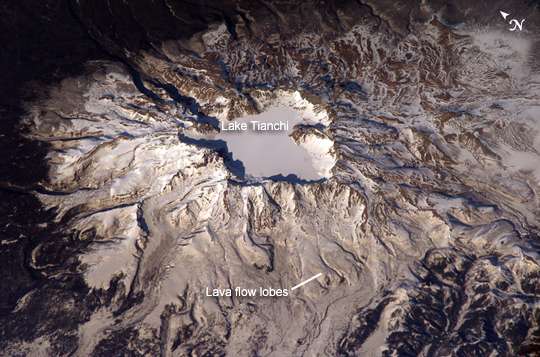April 18, 2016 report
International team gets a seismic look at North Korean/Chinese volcano

(Phys.org)—A team with members from the U.K., the U.S., China and the Democratic People's Republic of North Korea, has worked together to learn more about a volcano sitting on the North Korea/Chinese border. In their paper published in the journal Science Advances, the team describes how they set up seismic monitors and collected data for a two year period and what that data revealed.
North Korea, as most are aware, is a secretive country, allowing very little information in our out regarding almost everything, and that includes geological data. Unfortunately, this has until recently included what has been described as a dangerous volcano on the border between North Korea and China—back in 946 AD it went off in what has been called one of the largest eruptions on record. It also sits in the vicinity of 1.6 million people. The volcano is called Mount Paektu on the Korean side and Changbaishan on the Chinese side. North Korean researchers have been studying the volcano for some time on their side of the border and Chinese researchers have been studying their side—what has been missing is a concerted effort to study the volcano as a whole to both learn more about it, and to see if it might be possible to determine if the volcano is likely to erupt again anytime soon.
The collaborative effort consisted of setting up six state-of-the-art seismic monitors in a 60 kilometer-long line east from the summit to far into the countryside and monitoring them for the period August 2013 to August 2015. Analysis of the data from the monitors revealed a large portion of the crust below the volcano appeared to be at least partially molten, a hint that the volcano could erupt. The team also studied the area around the volcano, looking for debris thrown from the volcano during prior eruptions, and found evidence of superheated clouds of very hot gasses and ashes sweeping downhill along with large mudslides. That suggested that if the volcano erupts again, it could cause serious flooding if the summit lake is unleashed, or worse a worldwide climate impact as ash is pushed into the sky and sulfur dioxide is released.
More information: R. Kyong-Song et al. Evidence for partial melt in the crust beneath Mt. Paektu (Changbaishan), Democratic Peoples Republic of Korea and China, Science Advances (2016). DOI: 10.1126/sciadv.1501513
Abstract
Mt. Paektu (also known as Changbaishan) is an enigmatic volcano on the border between the Democratic People's Republic of Korea (DPRK) and China. Despite being responsible for one of the largest eruptions in history, comparatively little is known about its magmatic evolution, geochronology, or underlying structure. We present receiver function results from an unprecedented seismic deployment in the DPRK. These are the first estimates of the crustal structure on the DPRK side of the volcano and, indeed, for anywhere beneath the DPRK. The crust 60 km from the volcano has a thickness of 35 km and a bulk VP/VS of 1.76, similar to that of the Sino-Korean craton. The VP/VS ratio increases ~20 km from the volcano, rising to >1.87 directly beneath the volcano. This shows that a large region of the crust has been modified by magmatism associated with the volcanism. Such high values of VP/VS suggest that partial melt is present in the crust beneath Mt. Paektu. This region of melt represents a potential source for magmas erupted in the last few thousand years and may be associated with an episode of volcanic unrest observed between 2002 and 2005.
Journal information: Science Advances
© 2016 Phys.org



















